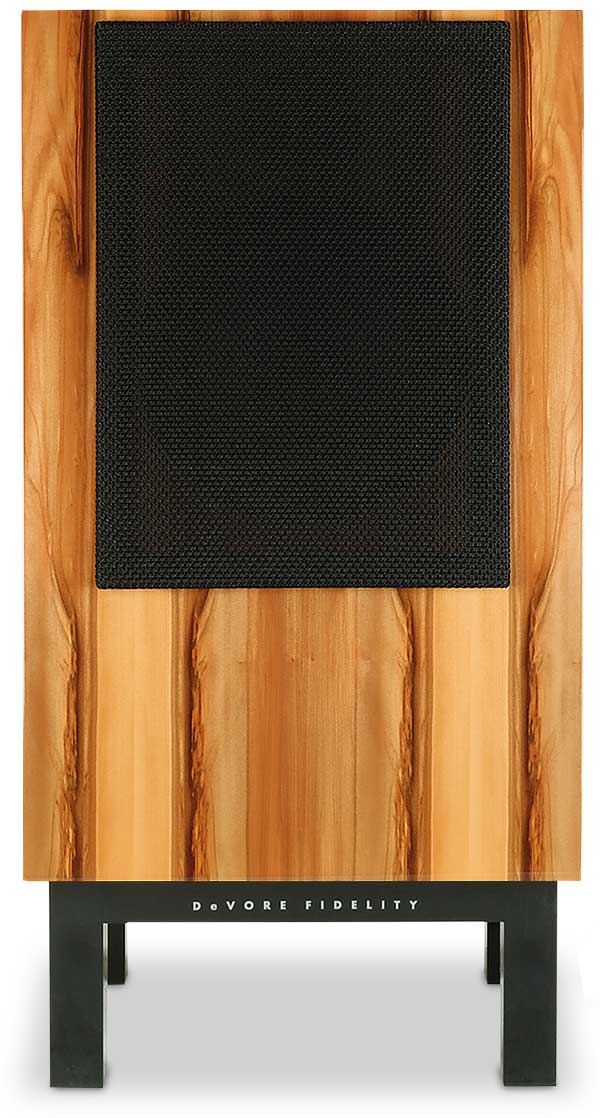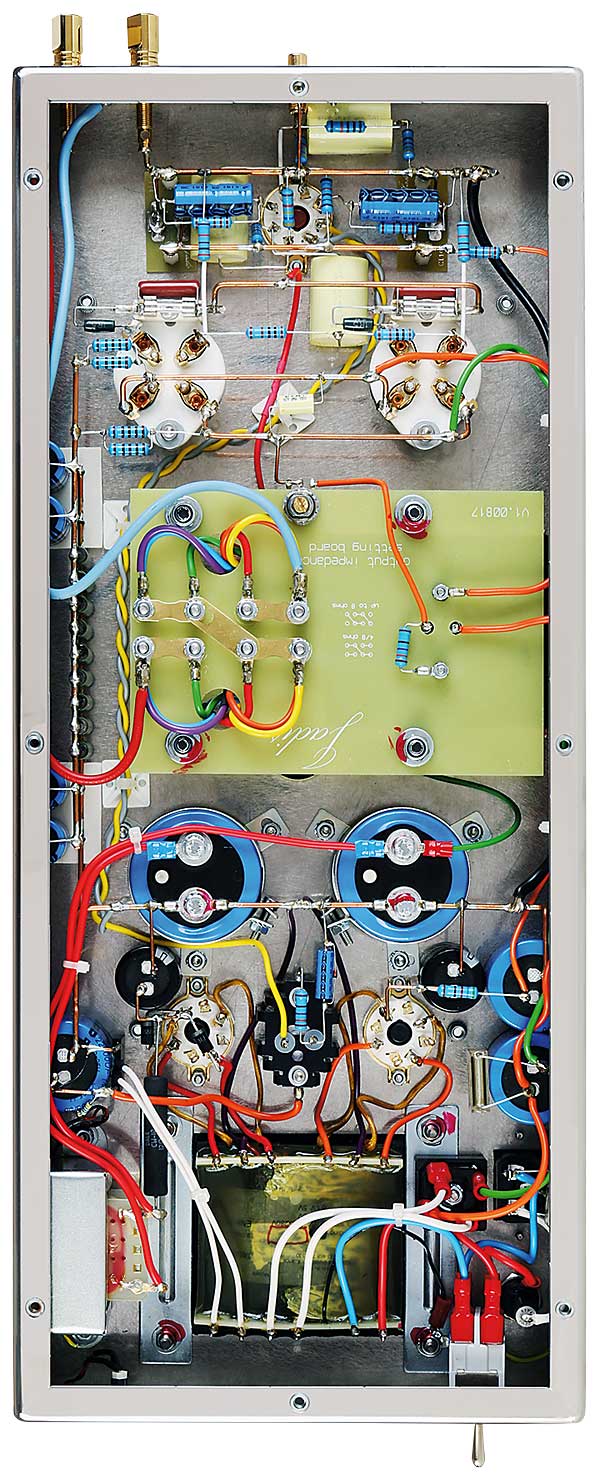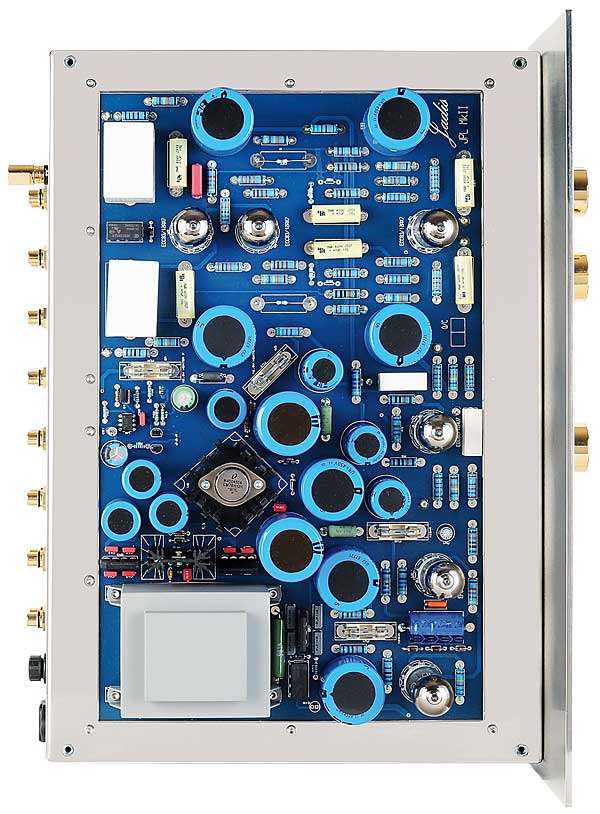Jadis JPL MkII/SE300B & DeVore Fidelity O/96 Tube Amp/Speaker System Page 2
![]() Art Mimics Life
Art Mimics Life
Long before I had the O/96s singing so sweetly they'd reminded me of another wide-baffle two-way speaker that I used throughout the 1990s – the AN-E from Audio Note. Many of you will have seen and heard this bluff-looking but sophisticated-sounding box at hi-fi shows where its ability to cast very plausible stereo images over a wide listening area has made them a go-to choice for 'group listening'.

The O/96s have a similar ability although they are less inclined to favour a corner or near-wall siting, delivering their most open and transparent sound when positioned clear of boundaries and toed-in towards the listening position. This suggests they have something of a sweet spot, broad though this is by the standards of more narrowly-focused 'skinny' speakers.
Transparency is a term all too readily bandied about in reviews, but the O/96s truly exhibit this quality. The instant you hear these boxes in action then 99% of other 'boxes' sound, well, like they need a kick up the pants to get them going. The O/96s simply do not reveal themselves as a 'sound source' – their 'touch' is so light that the faintest of notes and sounds seem to slip unhindered into the room. Whether this is a by-product of their high sensitivity, or a happy coincidence – that elusive 'synergy' with the Jadis SETs – I do not know. But, like a fixed point in space, it is a repeatable, reliable and defining quality of this combination. A quality that's leveraged to typically jaw-dropping effect by, surely, every one of your favourite vocal-driven albums. If you ever wanted to contrast the vocal styles expressed in Kate Bush's 50 Words For Snow [Fish People FPCD007; 96kHz/24-bit] with Rebecca Pidgeon's 'Spanish Harlem' [The Raven, Chesky; 96kHz/24-bit] and Jennifer Warnes' 'Way Down Deep' [The Hunter, Private Music 261974; 44.1kHz/16-bit] then this Jadis and DeVore pairing will conjure each of these performers for a very up-close and personal inspection. Every breath, every subtle sibilant, every lick of the lips – 'vivid' fails to convey the startlingly palpable presence of these voices in the room.
Breathe The Air
Its reproduction of ambience and atmosphere is similarly tangible. Listening to Mike Oldfield taking a trip back down a 40-plus year-old memory lane with Return To Ommadawn [Mercury; 96kHz/24-bit], the progression of some 23 instruments and associated styles – an evolution of Celtic folk through to progressive pop – was also a 'living' exploration of the musical capability of the Jadis/DeVore system. There was exquisite subtlety here, and delicate shades of colour, the ambience not only immersive but also filled with pin-sharp images. And there was power too, a realistic sense of edge and bite where notes would rise without inertia and decay without haste.

It was at once lyrical, engaging and relaxing while leaving the listener in no doubt that whipcrack percussion or the surge of raw, thrilling strings could pounce at any second. The power was latent while the atmosphere was confidently relaxed – it's a bewitchingly engaging combination.
And so, two-thirds of the way through this 21-minute tour, the room was shaken by African table drums. There was no suggestion that these under-powered SETs had lost their grip or control over the resonant impact of percussion, no loss of puff, just as there was no distorted modulation between the thrilling acoustic strings or background synth. Each layer in the multi-track was explicitly clear and utterly in harmony with its partnering 'performers', albeit played and sync'd by just one man.
Playing Devil's advocate, if you really want to catch out these components then you can. There is necessarily a limit to the available headroom, and the DeVore O/96s, sensitive though they are, can sink more power than the SE300Bs are capable of offering. Select '67000mph' by Phronesis [Parallax, Edition Records; 88.2kHz/24-bit] and wind up the wick just a little too far and you'll hear Anton Eger's explosive drum intro veer from taut, powerful and strikingly ambient to 'uh oh, I've bust a skin...'.
Keep within its limits – loud enough for those New York apartments – and the contrast between the thump of drums and crack of sticks on rims is stunning in its separation and detail. As the remainder of this Anglo-Scandanavian jazz trio join at, well, 67000mph the double bass and piano duck and dive but never collide.
Stealth Tactics
Very deep, under-the-radar, bass can remain invisible to the SE300Bs. There's no segue from slam to sludge here, but listening to the 2012 remix of Massive Attack's 'Unfinished Symphony' [Blue Lines, Wild Bunch Records; 96kHz/24-bit] I was conscious of the opening salvo being somewhat diminished in its gravitas. There was punch and depth here, and the anticipated firm, metronomic rhythm, but the O/96s are capable of digging deeper and lifting heavier. I know this because: 1. I measured them, and 2. I sneaked in a quick session with the Constellation Audio monoblocks...
And yet I was still eager to return to the Jadis/DeVore pairing for the sheer pleasure of hearing music replayed in a fashion that almost always elicited an emotional connection. Yes, they have their foibles, but not so much that you'll find your choice of music unduly restricted.

For example, these (relatively) compact speakers are more than capable of hosting a very grand stage, as the 'Symphonic' version of Pink Floyd's Wish You Were Here [London Orion Orchestra; Decca 478 9517] served to illustrate. Skip over Alice Cooper's vocal intervention to the ethereal, glittering intro of 'Shine On...'. Here the glockenspiel, strings and horns – the orchestra conducted by Peter Scholes – sets the scene for the by-now iconic four-note mantra struck up by guitarists loaned from the Australian Pink Floyd Show. Again, it's this Jadis/DeVore combo's ability to resolve the exquisite fragility of the background percussion while juggling the surge of strings, the biting edge of guitar and Rick Wakeman's trademark life-of-their-own keyboards that's so, well, exciting.
Abracadabra
So while the figures for harmonic distortion are high (and, sorry SET fans, there's as much 3rd as 2nd here) the perceived timbres of these disparate acoustic and electronic instruments are as clear as the proverbial bell, or bells. I've certainly heard many a purported low-coloration system sound more dynamically compressed, less spatially coherent and plainly more muddled than this ostensibly leftfield combination.
It's not magic, but neither is the deeply compelling, emotionally engaging and thoroughly addictive sound of this system entirely predictable by currently received science and engineering wisdom. Which, of course, is all part and parcel of the fun and 'mystery' of hi-fi, and why we audiophiles love to mix 'n match our separates. And long may it remain so.
Hi-Fi News Verdict
With performance aspirations seemingly well beyond its capacity, this marriage of French SET amplification with New York's least demanding loudspeakers still delivers on its promise. To every audiophile wedded to high power and statuesque floorstanders, I say this: negotiate yourself a Hall Pass and spend an evening with this baroque partnership instead. You're guaranteed a (musical) experience you'll not forget!























































